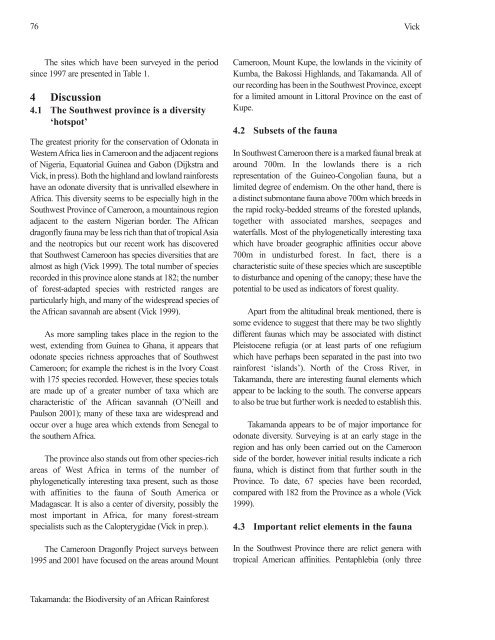Fisheries in the Southern Border Zone of Takamanda - Impact ...
Fisheries in the Southern Border Zone of Takamanda - Impact ...
Fisheries in the Southern Border Zone of Takamanda - Impact ...
Create successful ePaper yourself
Turn your PDF publications into a flip-book with our unique Google optimized e-Paper software.
76<br />
The sites which have been surveyed <strong>in</strong> <strong>the</strong> period<br />
s<strong>in</strong>ce 1997 are presented <strong>in</strong> Table 1.<br />
4 Discussion<br />
4.1 The Southwest prov<strong>in</strong>ce is a diversity<br />
‘hotspot’<br />
The greatest priority for <strong>the</strong> conservation <strong>of</strong> Odonata <strong>in</strong><br />
Western Africa lies <strong>in</strong> Cameroon and <strong>the</strong> adjacent regions<br />
<strong>of</strong> Nigeria, Equatorial Gu<strong>in</strong>ea and Gabon (Dijkstra and<br />
Vick, <strong>in</strong> press). Both <strong>the</strong> highland and lowland ra<strong>in</strong>forests<br />
have an odonate diversity that is unrivalled elsewhere <strong>in</strong><br />
Africa. This diversity seems to be especially high <strong>in</strong> <strong>the</strong><br />
Southwest Prov<strong>in</strong>ce <strong>of</strong> Cameroon, a mounta<strong>in</strong>ous region<br />
adjacent to <strong>the</strong> eastern Nigerian border. The African<br />
dragonfly fauna may be less rich than that <strong>of</strong> tropical Asia<br />
and <strong>the</strong> neotropics but our recent work has discovered<br />
that Southwest Cameroon has species diversities that are<br />
almost as high (Vick 1999). The total number <strong>of</strong> species<br />
recorded <strong>in</strong> this prov<strong>in</strong>ce alone stands at 182; <strong>the</strong> number<br />
<strong>of</strong> forest-adapted species with restricted ranges are<br />
particularly high, and many <strong>of</strong> <strong>the</strong> widespread species <strong>of</strong><br />
<strong>the</strong> African savannah are absent (Vick 1999).<br />
As more sampl<strong>in</strong>g takes place <strong>in</strong> <strong>the</strong> region to <strong>the</strong><br />
west, extend<strong>in</strong>g from Gu<strong>in</strong>ea to Ghana, it appears that<br />
odonate species richness approaches that <strong>of</strong> Southwest<br />
Cameroon; for example <strong>the</strong> richest is <strong>in</strong> <strong>the</strong> Ivory Coast<br />
with 175 species recorded. However, <strong>the</strong>se species totals<br />
are made up <strong>of</strong> a greater number <strong>of</strong> taxa which are<br />
characteristic <strong>of</strong> <strong>the</strong> African savannah (O’Neill and<br />
Paulson 2001); many <strong>of</strong> <strong>the</strong>se taxa are widespread and<br />
occur over a huge area which extends from Senegal to<br />
<strong>the</strong> sou<strong>the</strong>rn Africa.<br />
The prov<strong>in</strong>ce also stands out from o<strong>the</strong>r species-rich<br />
areas <strong>of</strong> West Africa <strong>in</strong> terms <strong>of</strong> <strong>the</strong> number <strong>of</strong><br />
phylogenetically <strong>in</strong>terest<strong>in</strong>g taxa present, such as those<br />
with aff<strong>in</strong>ities to <strong>the</strong> fauna <strong>of</strong> South America or<br />
Madagascar. It is also a center <strong>of</strong> diversity, possibly <strong>the</strong><br />
most important <strong>in</strong> Africa, for many forest-stream<br />
specialists such as <strong>the</strong> Calopterygidae (Vick <strong>in</strong> prep.).<br />
The Cameroon Dragonfly Project surveys between<br />
1995 and 2001 have focused on <strong>the</strong> areas around Mount<br />
<strong>Takamanda</strong>: <strong>the</strong> Biodiversity <strong>of</strong> an African Ra<strong>in</strong>forest<br />
Cameroon, Mount Kupe, <strong>the</strong> lowlands <strong>in</strong> <strong>the</strong> vic<strong>in</strong>ity <strong>of</strong><br />
Kumba, <strong>the</strong> Bakossi Highlands, and <strong>Takamanda</strong>. All <strong>of</strong><br />
our record<strong>in</strong>g has been <strong>in</strong> <strong>the</strong> Southwest Prov<strong>in</strong>ce, except<br />
for a limited amount <strong>in</strong> Littoral Prov<strong>in</strong>ce on <strong>the</strong> east <strong>of</strong><br />
Kupe.<br />
4.2 Subsets <strong>of</strong> <strong>the</strong> fauna<br />
Vick<br />
In Southwest Cameroon <strong>the</strong>re is a marked faunal break at<br />
around 700m. In <strong>the</strong> lowlands <strong>the</strong>re is a rich<br />
representation <strong>of</strong> <strong>the</strong> Gu<strong>in</strong>eo-Congolian fauna, but a<br />
limited degree <strong>of</strong> endemism. On <strong>the</strong> o<strong>the</strong>r hand, <strong>the</strong>re is<br />
a dist<strong>in</strong>ct submontane fauna above 700m which breeds <strong>in</strong><br />
<strong>the</strong> rapid rocky-bedded streams <strong>of</strong> <strong>the</strong> forested uplands,<br />
toge<strong>the</strong>r with associated marshes, seepages and<br />
waterfalls. Most <strong>of</strong> <strong>the</strong> phylogenetically <strong>in</strong>terest<strong>in</strong>g taxa<br />
which have broader geographic aff<strong>in</strong>ities occur above<br />
700m <strong>in</strong> undisturbed forest. In fact, <strong>the</strong>re is a<br />
characteristic suite <strong>of</strong> <strong>the</strong>se species which are susceptible<br />
to disturbance and open<strong>in</strong>g <strong>of</strong> <strong>the</strong> canopy; <strong>the</strong>se have <strong>the</strong><br />
potential to be used as <strong>in</strong>dicators <strong>of</strong> forest quality.<br />
Apart from <strong>the</strong> altitud<strong>in</strong>al break mentioned, <strong>the</strong>re is<br />
some evidence to suggest that <strong>the</strong>re may be two slightly<br />
different faunas which may be associated with dist<strong>in</strong>ct<br />
Pleistocene refugia (or at least parts <strong>of</strong> one refugium<br />
which have perhaps been separated <strong>in</strong> <strong>the</strong> past <strong>in</strong>to two<br />
ra<strong>in</strong>forest ‘islands’). North <strong>of</strong> <strong>the</strong> Cross River, <strong>in</strong><br />
<strong>Takamanda</strong>, <strong>the</strong>re are <strong>in</strong>terest<strong>in</strong>g faunal elements which<br />
appear to be lack<strong>in</strong>g to <strong>the</strong> south. The converse appears<br />
to also be true but fur<strong>the</strong>r work is needed to establish this.<br />
<strong>Takamanda</strong> appears to be <strong>of</strong> major importance for<br />
odonate diversity. Survey<strong>in</strong>g is at an early stage <strong>in</strong> <strong>the</strong><br />
region and has only been carried out on <strong>the</strong> Cameroon<br />
side <strong>of</strong> <strong>the</strong> border, however <strong>in</strong>itial results <strong>in</strong>dicate a rich<br />
fauna, which is dist<strong>in</strong>ct from that fur<strong>the</strong>r south <strong>in</strong> <strong>the</strong><br />
Prov<strong>in</strong>ce. To date, 67 species have been recorded,<br />
compared with 182 from <strong>the</strong> Prov<strong>in</strong>ce as a whole (Vick<br />
1999).<br />
4.3 Important relict elements <strong>in</strong> <strong>the</strong> fauna<br />
In <strong>the</strong> Southwest Prov<strong>in</strong>ce <strong>the</strong>re are relict genera with<br />
tropical American aff<strong>in</strong>ities. Pentaphlebia (only three

















